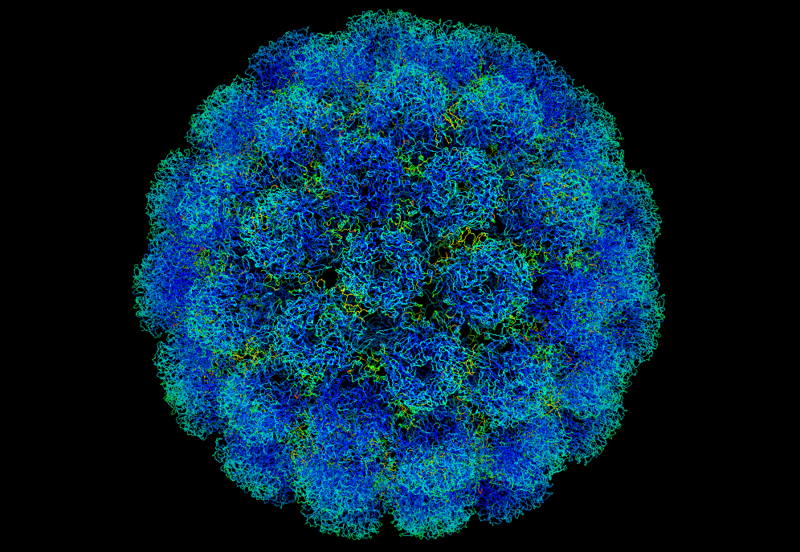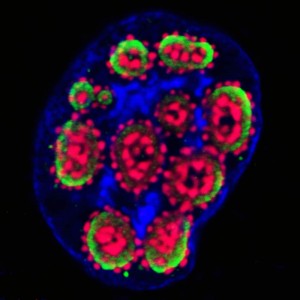Simian Virus 40 and SV40 large T antigen protein
Simian Virus 40 belongs to thePolyomaviridaevirus family. It is a DNA virus which can infect different vertebrate species, with the capability of causing solid tumors. During SV40 viral infection, its replication is maintained by viral proteins together with the host replication machinery.
The SV40 large T antigen is a major regulator of SV40 replication. SV40 large T antigen is an hexameric DNA helicase early transcribed during viral infection. In addition to its function in viral replication, it has a role in inactivation of tumor suppressor proteins like p53 and Rb proteins, inducing entry in S phase and thus promoting viral replication (Saenz Robles and Pipas, 2009)
The SV40 T antigen has been widely used in biological research as an inducerof cell line immortalization and as well for the generation of transgenic mouse models of human cancers (Colvin 2014). Both methods have contributedto our current understanding of cancer biology.

Ultra fast temperature shift device for in vitro experiments under microscopy
Temperature sensitive mutants of SV40 large T antigen
A temperature sensitive version of the SV40 large T antigen, the tsA58, has been used as a powerful tool for conditional cell line transformation. Transformed cell lines proliferate at the permissive temperature (33°C) but show proliferation arrest when shifted to restrictive temperature (39°C), upon T antigen inactivation (Jat and Sharp 1989).The use of ts mutants allowed for the initial understanding of the function ofthe T antigen protein in cell transformation (Brugge andButel 1975). Additional temperature-sensitive (t.s) mutations of SV40 large T antigen have been described (Ray 1992).
Conditional inactivation of SV40 large T antigen has been used, for instance, to induce senescencein fibroblasts in a temperature regulated manner (Brookes 2015), to generate conditionally immortalized epithelial cell lines from transgenic mice (Whitehead and Robinson 2009), or to generate conditionally immortalized cell lines for blood-brain barrier models (Terasaki 2003).
The use of temperature sensitive mutant proteins remains a widespread method for conditional inactivation of proteins in multiple model organisms and cell lines. Temperature shifts are efficient, easy to perform, and with minoroff-target effects as opposed to protein inactivation with chemicals.
References
Brookes et al. Cell Cycle. 2015;14(8):1164-73.
Colvin et al. Semin Cell Dev Biol. 2014 Mar;27:61-73.
Saenz Robles and Pipas, Semin Cancer Biol. 2009 Aug;19(4):229-35.
Whitehead and Robinson Am J PhysiolGastrointest Liver Physiol. 2009 Mar; 296(3): G455–G460.
Terasaki 2003, Drug Discov Today. 2003 Oct 15;8(20):944-54.
Ray et al. J Virol. 1992 Nov; 66(11): 6509–6516.
Jat and Sharp. Mol. Cell. Biol. April 1989 vol. 9no. 4 1672-1681
Bruggeand Butel. J Virol. 1975 Mar;15(3):619-35
FAQ
Simian Virus 40 (SV40) is a DNA virus from the Polyomaviridae family that can infect various vertebrate species and is capable of causing solid tumours. During its infection cycle, viral replication is maintained by SV40’s own proteins along with the host cell’s replication machinery. The SV40 large T antigen is a main regulator of this viral replication process. It is a hexameric DNA helicase that is transcribed early during the infection. In addition to its role in viral replication, the T antigen also functions to inactivate tumour suppressor proteins, such as p53 and Rb. This action induces the host cell to enter the S phase, which in turn promotes the replication of the virus.
The SV40 T antigen has been used in biological research for two primary applications. It is employed as an inducer for the immortalisation of cell lines. It is also used for the generation of transgenic mouse models designed to study human cancers. Both of these methods have reportedly contributed to the current understanding of cancer biology. The protein’s function includes the inactivation of tumour suppressor proteins like p53 and Rb. This inactivation induces the cell’s entry into the S phase. This mechanism of promoting cell proliferation is harnessed by researchers for immortalising cells in culture or for generating cancer models in animals.
A temperature-sensitive (ts) mutant is a specific version of the SV40 large T antigen protein. The tsA58 variant is one such mutant that has been used as a tool for conditional cell line transformation. The use of ts mutants, such as those described by Brugge and Butel, allowed for an initial understanding of the T antigen protein’s function in cell transformation. Additional temperature-sensitive mutations of the protein have also been described since then. This type of mutant protein allows its activity to be controlled by the environment. The protein is active at one temperature but becomes inactive when the temperature is changed to a different, non-permissive level.
Conditional cell line transformation uses temperature-sensitive mutants like tsA58. Cell lines that have been transformed with this mutant will proliferate when they are maintained at the permissive temperature, which is 33°C. However, these same cells show proliferation arrest when they are shifted to the restrictive temperature of 39°C. This cessation of proliferation occurs because the T antigen protein is inactivated at the higher, restrictive temperature. This method has been used, for example, to induce senescence in fibroblasts in a temperature-regulated manner. It has also been applied to generate conditionally immortalised epithelial cell lines from transgenic mice and to create cell lines for blood-brain barrier models.
The use of temperature-sensitive mutant proteins is a method for achieving conditional inactivation of proteins in multiple model organisms and cell lines. This approach has certain benefits compared to inactivation with chemicals. Temperature shifts are described as efficient. They are also considered easy to perform in a laboratory setting. Furthermore, this method is noted to have minor off-target effects. This is different from chemical inactivation methods, which may introduce other unintended effects within the cells. These attributes make temperature control a useful technique for researchers studying protein function.




